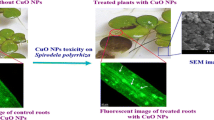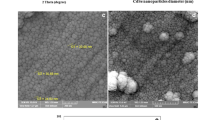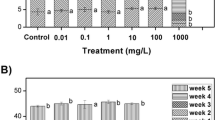Abstract
Plants play an important role in the fate of nanoparticles in the environment through their uptake, bioaccumulation, and transfer to trophic chains. However, the impacts of nanoparticles on plants as essential components of all ecosystems are not well documented. In the present study, the toxic effects of l-Cysteine-capped CdS nanoparticles on Spirodela polyrrhiza as an aquatic higher plant species were studied. l-Cysteine-capped CdS nanoparticles were synthesized using hydrothermal method and their characteristics were determined by XRD, SEM, HR-TEM, and FT-IR techniques. The diameter of majority of synthesized nanoparticles was about 15–20 nm. Subsequently, the uptake of l-Cysteine-capped CdS nanoparticles by the plant species was confirmed using epifluorescence microscopy. The activity of peroxidase and superoxide dismutase as antioxidant enzymes was assayed and the relative frond number was calculated in the presence of different concentrations of l-Cysteine-capped CdS nanoparticles. The obtained results revealed the toxic effects of the synthesized nanoparticles on S. polyrrhiza, leading to growth reduction and significant changes in antioxidant enzymes’ activity.
Graphical Abstract












Similar content being viewed by others
References
Alscher RG, Erturk N, Heath LS (2002) Role of superoxide dismutases (SODs) in controlling oxidative stress in plants. J Exp Bot 53:1331–1341
Alvarez C, Angeles Bermudez M, Romero LC, Gotor C, Garcia I (2012) Cysteine homeostasis plays an essential role in plant immunity. New Phytol 193:165–177
Ball P (2002) Natural strategies for the molecular engineer. Nanotechnology 13:15–28
Bradford MM (1976) A rapid and sensitive method for the quantitation of microgram quantities of protein utilizing the principle of protein-dye binding. Anal Biochem 72:248–254
Brayner R, Dahoumane SA, Nguyen JN-L, Yepremian C, Djediat C, Coute A, Fievet F (2011) Ecotoxicological studies of CdS nanoparticles on photosynthetic microorganisms. J Nanosci Nanotechnol 11:1852–1858
Cai Z-X, Yang H, Zhang Y, Yan X-P (2006) Preparation, characterization and evaluation of water-soluble l-cysteine-capped-CdS nanoparticles as fluorescence probe for detection of Hg(II) in aqueous solution. Anal Chim Acta 559:234–239
Chance B, Maehly A (1955) Assay of catalases and peroxidases. Methods Enzymol 2:764–775
Chen J-L, Zhu C-Q (2005) Functionalized cadmium sulfide quantum dots as fluorescence probe for silver ion determination. Anal Chim Acta 546:147–153
Christian P, Von der Kammer F, Baalousha M, Hofmann T (2008) Nanoparticles: structure, properties, preparation and behaviour in environmental media. Ecotoxicology 17:326–343
Dosnon-Olette R, Couderchet M, El Arfaoui A, Sayen S, Eullaffroy P (2010) Influence of initial pesticide concentrations and plant population density on dimethomorph toxicity and removal by two duckweed species. Sci Total Environ 408:2254–2259
El-Ansary A, Al-Daihan S (2009) On the toxicity of therapeutically used nanoparticles: an overview. J Toxicol. doi:10.1155/2009/754810
Gubbins EJ, Batty LC, Lead JR (2011) Phytotoxicity of silver nanoparticles to Lemna minor L. Environ Pollut 159:1551–1559
Havaux M (2003) Spontaneous and thermoinduced photon emission: new methods to detect and quantify oxidative stress in plants. Trends Plant Sci 8:409–413
Hossain ST, Mukherjee SK (2013) Toxicity of cadmium sulfide (CdS) nanoparticles against Escherichia coli and HeLa cells. J Hazard Mater 260:1073–1082
Jamieson T, Bakhshi R, Petrova D, Pocock R, Imani M, Seifalian AM (2007) Biological applications of quantum dots. Biomaterials 28:4717–4732
Jia G, Wang H, Yan L, Wang X, Pei R, Yan T, Zhao Y, Guo X (2005) Cytotoxicity of carbon nanomaterials: single-wall nanotube, multi-wall nanotube, and fullerene. Environ Sci Technol 39:1378–1383
Jiang R, Zhu H, Li X, Xiao L (2009) Visible light photocatalytic decolourization of CI Acid Red 66 by chitosan capped CdS composite nanoparticles. Chem Eng J 152:537–542
Jiang H-S, Li M, Chang F-Y, Li W, Yin L-Y (2012) Physiological analysis of silver nanoparticles and AgNO3 toxicity to Spirodela polyrhiza. Environ Toxicol Chem 31:1880–1886
Khataee AR, Kasiri MB (2011) Artificial neural network modeling of water and wastewater treatment processes. NOVA Science Publisher, Inc, USA
Khataee AR, Aber S, Zarei M, Sheydaei M (2011) Environmental applications of activated carbon and carbon nanotubes. NOVA Science Publisher, Inc, USA
Khataee A, Movafeghi A, Torbati S, Salehi Lisar S, Zarei M (2012) Phytoremediation potential of duckweed (Lemna minor L.) in degradation of CI Acid Blue 92: artificial neural network modeling. Ecotoxicol Environ Saf 80:291–298
Khataee A, Fathinia M, Joo S (2013) Simultaneous monitoring of photocatalysis of three pharmaceuticals by immobilized TiO2 nanoparticles: chemometric assessment, intermediates identification and ecotoxicological evaluation. Spectrochim Acta Part A 112:33–45
Klaine SJ et al (2008) Nanomaterials in the environment: behavior, fate, bioavailability, and effects. Environ Toxicol Chem 27:1825–1851
Koneswaran M, Narayanaswamy R (2009) l-Cysteine-capped ZnS quantum dots based fluorescence sensor for Cu 2+ ion. Sens Actuator B Chem 139:104–109
Kortan A, Hull R, Opila R, Bawendi M, Steigerwald M, Carroll P, Brus LE (1990) Nucleation and growth of cadmium selendie on zinc sulfide quantum crystallite seeds, and vice versa, in inverse micelle media. J Am Chem Soc 112:1327–1332
Kovochich M, Xia T, Xu J, Yeh JI, Nel AE (2007) Principles and procedures to assess nanomaterial toxicity environmental nanotechnology: applications and impacts of nanomaterials. McGraw Hill, New York, pp 205–229
Li H, Li M, Shih WY, Lelkes PI, Shih W-H (2011) Cytotoxicity tests of water soluble ZnS and CdS quantum dots. J Nanosci Nanotechnol 11:3543–3551
Ma-Hock L, Brill S, Wohlleben W, Farias P, Chaves C, Tenorio D, Fontes A, Santos B, Landsiedel R, Strauss V (2012) Short term inhalation toxicity of a liquid aerosol of CdS/Cd (OH)2 core shell quantum dots in male Wistar rats. Toxicol Lett 208:115–124
Mishra VK, Tripathi B (2008) Concurrent removal and accumulation of heavy metals by the three aquatic macrophytes. Bioresour Technol 99:7091–7097
Mishra P, Shukla VK, Yadav RS, Pandey AC (2013) Toxicity concerns of semiconducting nanostructures on aquatic plant Hydrilla verticillata. J Stress Physiol Biochem 9:287–298
Mitsou K, Koulianou A, Lambropoulou D, Pappas P, Albanis T, Lekka M (2006) Growth rate effects, responses of antioxidant enzymes and metabolic fate of the herbicide Propanil in the aquatic plant Lemna minor. Chemosphere 62:275–284
Monica RC, Cremonini R (2009) Nanoparticles and higher plants. Caryologia 62:161–165
Morelli E, Cioni P, Posarelli M, Gabellieri E (2012) Chemical stability of CdSe quantum dots in seawater and their effects on a marine microalga. Aquat Toxicol 122:153–162
Movafeghi A, Dadpour MR, Naghiloo S, Farabi S, Omidi Y (2010) Floral development in Astragalus caspicus Bieb. (Leguminosae: Papilionoideae: Galegeae). Flora 205:251–258
Niemeyer CM (2001) Nanoparticles, proteins, and nucleic acids: biotechnology meets materials science. Angew Chem Int Ed 40:4128–4158
Nowack B, Bucheli TD (2007) Occurrence, behavior and effects of nanoparticles in the environment. Environ Pollut 150:5–22
Philip D (2010) Rapid green synthesis of spherical gold nanoparticles using Mangifera indica leaf. Spectrochim Acta A 77:807–810
Pinto E, Sigaud-kutner T, Leitao MA, Okamoto OK, Morse D, Colepicolo P (2003) Heavy metal-induced oxidative stress in algai. J Phycol 39:1008–1018
Prabhu RR, Khadar MA (2005) Characterization of chemically synthesized CdS nanoparticles. Pramana 65:801–807
Pujalte I, Passagne I, Brouillaud B, Treguer M, Durand E, Ohayon-Courtes C, L’Azou B (2011) Cytotoxicity and oxidative stress induced by different metallic nanoparticles on human kidney cells. Part Fibre Toxicol 8:1–16
Rai U, Sinha S, Tripathi R, Chandra P (1995) Wastewater treatability potential of some aquatic macrophytes: removal of heavy metals. Ecol Eng 5:5–12
Roco MC (2003) Broader societal issues of nanotechnology. J Nanopart Res 5:181–189
Santos SMA, Dinis AM, Rodrigues DMF, Peixoto F, Videira RA, Jurado AS (2013) Studies on the toxicity of an aqueous suspension of C60 nanoparticles using a bacterium (gen. Bacillus) and an aquatic plant (Lemna gibba) as in vitro model systems. Aquat Toxicol 142–143:347–354
Seth CS, Chaturvedi PK, Misra V (2007) Toxic effect of arsenate and cadmium alone and in combination on giant duckweed (Spirodela polyrrhiza L.) in response to its accumulation. Environ Toxicol 22:539–549
Song G, Gao Y, Wu H, Hou W, Zhang C, Ma H (2012) Physiological effect of anatase TiO2 nanoparticles on Lemna minor. Environ Toxicol Chem 31:2147–2152
Syed A, Saraswati S, Kundu GC, Ahmad A (2013) Biological synthesis of silver nanoparticles using the fungus Humicola sp. and evaluation of their cytoxicity using normal and cancer cell lines. Spectrochim Acta A 114:144–147
Tedesco S, Doyle H, Blasco J, Redmond G, Sheehan D (2010) Oxidative stress and toxicity of gold nanoparticles in Mytilus edulis. Aquat Toxicol 100:178–186
Vafaei F, Movafeghi A, Khataee A, Zarei M, Salehi Lisar S (2013) Potential of Hydrocotyle vulgaris for phytoremediation of a textile dye: Inducing antioxidant response in roots and leaves. Ecotoxicol Environ Saf 93:128–134
Van der Oost R, Beyer J, Vermeulen NP (2003) Fish bioaccumulation and biomarkers in environmental risk assessment: a review. Environ Toxicol Pharmacol 13:57–149
Wang S, Yang S, Yang C, Li Z, Wang J, Ge W (2000) Poly (N-vinylcarbazole)(PVK) photoconductivity enhancement induced by doping with CdS nanocrystals through chemical hybridization. J Phys Chem B 104:11853–11858
Wen-wen C, Si-jia H, Chen-xi W, Qiang Z, Chuan-lu H, Juan D, Shu-mao D (2010) Cytotoxicity effects of nano-Fe3O4 on HeLa cells. In: Bioinformatics and Biomedical Engineering (iCBBE), 2010 4th International Conference on,. IEEE, pp 1–4
Winterbourn CC, McGrath BM, Carrell RW (1976) Reactions involving superoxide and normal and unstable haemoglobins. Biochem J 155:493–502
Xing W, Huang W, Liu G (2010) Effect of excess iron and copper on physiology of aquatic plant Spirodela polyrrhiza (L.) Schleid. Environ Toxicol 25:103–112
Zhu RR, Wang SL, Chao J, Shi DL, Zhang R, Sun XY, Yao SD (2009) Bio-effects of Nano-TiO2 on DNA and cellular ultrastructure with different polymorph and size. Mater Sci Eng C 29:691–696
Acknowledgments
The authors thank the University of Tabriz, Iran, for all support provided.
Author information
Authors and Affiliations
Corresponding authors
Rights and permissions
About this article
Cite this article
Khataee, A., Movafeghi, A., Nazari, F. et al. The toxic effects of l-Cysteine-capped cadmium sulfide nanoparticles on the aquatic plant Spirodela polyrrhiza . J Nanopart Res 16, 2774 (2014). https://doi.org/10.1007/s11051-014-2774-7
Received:
Accepted:
Published:
DOI: https://doi.org/10.1007/s11051-014-2774-7




